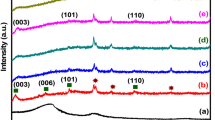Abstract
To fabricate a hybrid supercapacitor comprising activated carbon and TiO2 electrodes, anatase TiO2 was investigated as a candidate negative electrode material. It was synthesized by a combination of the sol-gel and microwave methods using dodecylamine as a structure directing agent. The synthesized TiO2 had uniform size (∼400 nm), a spherical morphology, a mesoporous structure (specific surface area = ∼100 m2g−1, pore size distribution = ∼10 nm), and anatase phase without any impurities. To balance the power and energy densities of positive (activated carbon) and negative electrodes (TiO2), each electrode was confirmed to have the specific capacity of about 190 mAh g−1 and 50 mAh g−1 (at 1 C-rate = 250 mA g−1) through half cell tests. While the specific capacitance (23 F cm−3) of the hybrid supercapacitor achieved about 28% increase compared to an existing supercapacitor (electric double-layer capacitor = 18 F cm−3) at a current density of 0.5 mA cm−2, it had a low retention ratio of 91% during 100 cycles due to the poor electronic conductivity of TiO2. However, it was confirmed that anatase TiO2 is suitable for use as a negative material in hybrid supercapacitors.
Similar content being viewed by others
References
J. Li and F. Gao, J. Power Sources 194, 1184 (2009).
S.-O. Kim and J. K. Lee, J. Nanosci. Nanotechnol. 12, 292 (2012).
Q. Wang, Z. Wen, and J. Li, J. Nanosci. Nanotechnol. 7, 3328 (2007).
C. Liu, F. Li, L.-P. Ma, and H.-M. Cheng, Adv. Energy. Mater. 22, E28 (2010).
M.-Y. Park, K.-Y. Chun, J.-S. Lee, D.-J. Kwak, Y.-M. Sung, and Y.-T. Hyun, Electron. Mater. Lett. 5, 109 (2009).
D. Chen, L. Cao, F. Huang, P. Imperia, Y. B. Cheng, and R. A. Caruso, J. Am. Chem. Soc. 132, 4438 (2010).
Y. Oh, S. Nam, S. Wi, S. Hong, and B. Park, Electron. Mater. Lett. 8, 91 (2012).
T. Brousse, R. Marchand, P. L. Taberna, and P. Simon, J. Power Sources 158, 571 (2006).
G. Wang, Z. Y. Liu, J. N. Wu, and Q. Lu, Mater. Lett. 71, 120 (2012).
D.-W. Wang, H.-T. Fang, F. Li, Z.-G. Chen, Q.-S. Zhong, G. Q. Lu, and H.-M. Cheng, Adv. Funct. Mater. 18, 3787 (2008).
R. van de Krol and A. Goossens, J. Appl. Phys. 90, 2235 (2001).
P. M. Dziewoński and M. Grzeszczuk, Electrochim. Acta. 55, 3336 (2010).
Author information
Authors and Affiliations
Corresponding author
Rights and permissions
About this article
Cite this article
Cho, MY., Park, SM., Kim, KB. et al. Synthesis of mesoporous spherical TiO2 and its application in negative electrode of hybrid supercapacitor. Electron. Mater. Lett. 9, 809–812 (2013). https://doi.org/10.1007/s13391-013-6017-3
Received:
Accepted:
Published:
Issue Date:
DOI: https://doi.org/10.1007/s13391-013-6017-3




